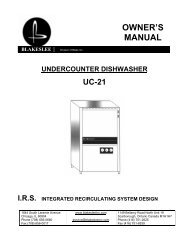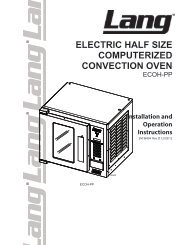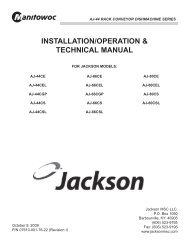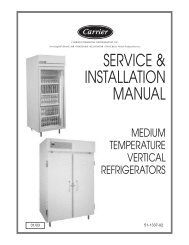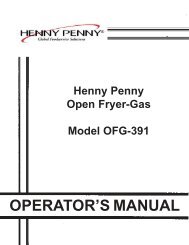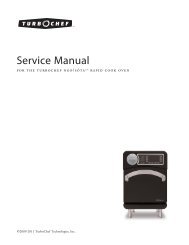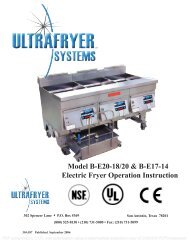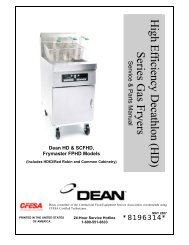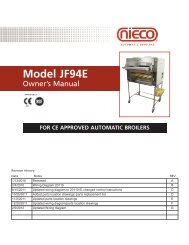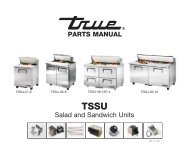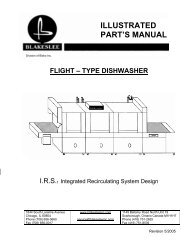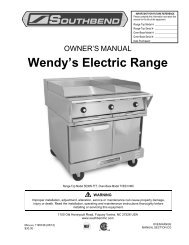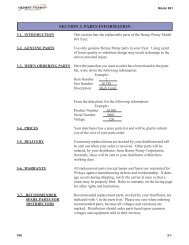OPERATOR MANUAL OM-DH/INA/2-100 - Parts Town
OPERATOR MANUAL OM-DH/INA/2-100 - Parts Town
OPERATOR MANUAL OM-DH/INA/2-100 - Parts Town
Create successful ePaper yourself
Turn your PDF publications into a flip-book with our unique Google optimized e-Paper software.
? IMPORTANT INFORMATION ? KEEP FOR <strong>OPERATOR</strong> ? IMPORTANT INFORMATION ?<br />
<strong>OPERATOR</strong> <strong>MANUAL</strong> <strong>OM</strong>-<strong>DH</strong>/<strong>INA</strong>/2-<strong>100</strong><br />
Part Number 121018 D<strong>OM</strong>ESTIC<br />
Model: <strong>DH</strong>/<strong>INA</strong>/2-<strong>100</strong><br />
Steam Jacketed Kettle<br />
Self-contained<br />
Gas heated<br />
Floor Mounted<br />
Tilting<br />
THIS <strong>MANUAL</strong> MUST BE RETAINED FOR FUTURE REFERENCE. READ, UNDERSTAND<br />
AND FOLLOW THE INSTRUCTIONS AND WARNINGS CONTAINED IN THIS <strong>MANUAL</strong>.<br />
FOR YOUR SAFETY<br />
DO NOT STORE OR USE GASOLINE OR OTHER FLAMMABLE VAPORS<br />
AND LIQUIDS IN THE VICINITY OF THIS OR ANY OTHER APPLIANCE.<br />
POST IN A PR<strong>OM</strong>INENT LOCATION<br />
INSTRUCTIONS TO BE FOLLOWED IN THE EVENT USER SMELLS GAS.<br />
THIS INFORMATION SHALL BE OBTAINED BY CONSULTING YOUR<br />
LOCAL GAS SUPPLIER. AS A MINIMUM, TURN OFF THE GAS AND CALL<br />
YOUR GAS C<strong>OM</strong>PANY AND YOUR AUTHORIZED SERVICE AGENT.<br />
EVACUATE ALL PERSONNEL FR<strong>OM</strong> THE AREA.<br />
WARNING: IMPROPER INSTALLATION, ADJUSTMENT, ALTERATION,<br />
SERVICE OR MAINTENANCE CAN CAUSE PROPERTY DAMAGE, INJURY<br />
OR DEATH. READ THE INSTALLATION, OPERATING AND<br />
MAINTENANCE INSTRUCTIONS THOROUGHLY BEFORE INSTALLING<br />
OR SERVICING THIS EQUIPMENT.<br />
Information contained in this document is<br />
known to be current and accurate at the time<br />
of printing/creation. Unified Brands recommends<br />
referencing our product line websites,<br />
unifiedbrands.net, for the most updated<br />
product information and specifications.
<strong>OM</strong>-<strong>DH</strong>/<strong>INA</strong>/2-<strong>100</strong><br />
IMPORTANT — READ FIRST — IMPORTANT<br />
WARNING: FAILURE TO DISCONNECT POWER BEFORE SERVICING COULD RESULT IN<br />
ELECTROCUTION AND DEATH.<br />
WARNING: IMPROPER INSTALLATION, ADJUSTMENT, ALTERATION, SERVICE OR MAINTENANCE<br />
CAN CAUSE PROPERTY DAMAGE, INJURY OR DEATH. READ THE INSTALLATION,<br />
OPERATING AND MAINTENANCE INSTRUCTIONS THOROUGHLY BEFORE INSTALLING OR<br />
SERVICING THIS EQUIPMENT.<br />
WARNING: DO NOT PLACE HANDS, TOOLS OR HOSES IN KETTLE WHILE AGITATOR IS MOVING.<br />
AGITATOR CAN BE JOGGED WHILE KETTLE IS TILTED.<br />
WARNING: THE UNIT MUST BE INSTALLED BY PERSONNEL QUALIFIED TO WORK WITH<br />
ELECTRICITY AND PLUMBING. UNIT MUST BE INSTALLED IN ACCORDANCE WITH ALL<br />
APPLICABLE CODES.<br />
WARNING: DO NOT ATTACH THE UNIT TO A TYPE “B” VENT. IT COULD CAUSE FIRE OR PROPERTY<br />
DAMAGE.<br />
WARNING: DO NOT CONNECT ANY PIPING TO THE SAFETY VALVE. IT MUST BE FREE TO VENT<br />
STEAM AS NEEDED. TO AVOID BURNS FR<strong>OM</strong> THE VENTED STEAM THE VALVE<br />
DISCHARGE SHOULD POINT DOWNWARD.<br />
DANGER: ELECTRICALLY GROUND THE UNIT AT THE TERM<strong>INA</strong>L PROVIDED. FAILURE TO GROUND<br />
THE UNIT COULD RESULT IN ELECTROCUTION AND DEATH.<br />
CAUTION: BE SURE ALL <strong>OPERATOR</strong>S READ, UNDERSTAND AND FOLLOW THE OPERATING<br />
INSTRUCTIONS, CAUTIONS AND SAFETY INSTRUCTIONS CONTAINED IN THIS <strong>MANUAL</strong>.<br />
CAUTION: DO NOT OVERFILL THE KETTLE WHEN COOKING, HOLDING OR CLEANING. KEEP<br />
LIQUIDS A MINIMUM OF 2-3" (5-8 CM) BELOW THE KETTLE BODY RIM TO ALLOW<br />
CLEARANCE FOR STIRRING, BOILING AND SAFE TRANSFER OF PRODUCT.<br />
CAUTION: KEEP FLOORS IN FRONT OF KETTLE WORK AREA CLEAN AND DRY. IF SPILLS OCCUR,<br />
CLEAN IMMEDIATELY TO AVOID SLIPS OR FALLS.<br />
WARNING: KEEP WATER AND SOLUTIONS OUT OF CONTROLS AND BURNERS. NEVER SPRAY OR<br />
HOSE DOWN THE CONTROL CONSOLE, ELECTRICAL CONNECTIONS, ETC.<br />
CAUTION: MOST CLEANERS ARE HARMFUL TO THE SKIN, EYES, MUCOUS MEMBRANES AND<br />
CLOTHING. TAKE PRECAUTIONS: WEAR RUBBER GLOVES, GOGGLES OR FACE SHIELD<br />
AND PROTECTIVE CLOTHING. CAREFULLY READ WARNINGS AND FOLLOW<br />
DIRECTIONS ON CLEANER LABELS .<br />
NOTICE: NEVER LEAVE A SANITIZER IN CONTACT WITH STAINLESS STEEL SURFACES LONGER<br />
THAN 10 MINUTES. LONGER CONTACT CAN CAUSE CORROSION.<br />
WARNING: FAILURE TO PERIODICALLY CHECK SAFETY VALVE OPERATION COULD RESULT IN<br />
PERSONAL INJURY AND/OR DAMAGE TO EQUIPMENT.<br />
WARNING: WHEN TESTING, AVOID EXPOSURE TO THE STEAM BLOWING OUT OF THE SAFETY<br />
VALVE. DIRECT CONTACT COULD RESULT IN SEVERE BURNS.<br />
WARNING: TO AVOID INJURY, READ AND FOLLOW ALL PRECAUTIONS STATED ON THE LABEL OF<br />
THE WATER TREATMENT C<strong>OM</strong>POUND.<br />
WARNING: BEFORE REPLACING ANY PARTS, DISCONNECT THE UNIT FR<strong>OM</strong> THE ELECTRIC POWER<br />
SUPPLY AND CLOSE THE MAIN GAS VALVE. ALLOW FIVE MINUTES FOR GAS TO VENT.<br />
CAUTION: USE OF ANY REPLACEMENT PARTS OTHER THAN THOSE SUPPLIED BY GROEN OR<br />
AUTHORIZED DISTRIBUTORS CAN CAUSE INJURY TO THE <strong>OPERATOR</strong> AND DAMAGE TO<br />
THE EQUIPMENT AND WILL VOID ALL WARRANTIES.<br />
Important: Service Performed by Other than Factory Authorized Personnel Will Void All Warranties.<br />
WARNING: KEEP AREA AROUND KETTLE FREE AND CLEAR OF ALL C<strong>OM</strong>BUSTIBLE MATERIALS.<br />
FAILURE TO DO SO COULD RESULT IN FIRE OR PROPERTY DAMAGE.<br />
WARNING: OPENING BOTT<strong>OM</strong> DROP VALVE EMPTIES KETTLE CONTENTS. CONTENTS MAY BE<br />
HOT.<br />
CAUTION: HEATING AN EMPTY KETTLE MAY CAUSE THE RELEASE OF STEAM FR<strong>OM</strong> THE SAFETY<br />
VALVE.<br />
2
Table of Contents<br />
3<br />
<strong>OM</strong>-<strong>DH</strong>/<strong>INA</strong>/2-<strong>100</strong><br />
INSTALLER AND <strong>OPERATOR</strong> WARNINGS ..................................... 2<br />
EQUIPMENT DESCRIPTION ................................................. 4<br />
INSPECTION & UNPACKING ................................................ 5<br />
INSTALLATION & START-UP ................................................ 7<br />
OPERATION ............................................................. 9<br />
CLEANING .............................................................. 12<br />
PREVENTIVE MAINTENANCE .............................................. 15<br />
SEQUENCE OF OPERATION ............................................... 16<br />
MAINTENANCE ......................................................... 17<br />
TROUBLESHOOTING (<strong>OPERATOR</strong>) ......................................... 18<br />
PARTS LISTS & SCHEMATICS .............................................. 20<br />
REFERENCES ........................................................... 37<br />
SERVICE LOG ........................................................... 38<br />
WARRANTY ............................................................. 39
<strong>OM</strong>-<strong>DH</strong>/<strong>INA</strong>/2-<strong>100</strong><br />
Groen Model <strong>DH</strong>/<strong>INA</strong>/2-<strong>100</strong> is a stainless steel,<br />
steam jacketed, floor mounted, tilting kettle with a<br />
self-contained, gas heated steam source. The<br />
Model <strong>DH</strong>/<strong>INA</strong>/2-<strong>100</strong> is equipped with the <strong>INA</strong>/2<br />
style inclined agitator/mixer. The kettle body is<br />
welded into one piece and furnished with a<br />
reinforced bar rim and welded “butterfly” pouring lip.<br />
The interior of the kettle is polished to a 180 emery<br />
grit finish and the exterior given a uniform Number 4<br />
finish.<br />
The unit is ASME shop-inspected and is registered<br />
with the National Board for working pressures up to<br />
50 PSI. Kettle supports mount directly to the floor by<br />
use of lag bolts. A power tilt feature is standard.<br />
Options available include: Air-operated bottom outlet<br />
valve, 1½, two or three inch manual ball valve,<br />
“Gallon Master” metering system, product outlet<br />
strainer, and Honeywell DPR <strong>100</strong>C Recorder.<br />
Equipment Description<br />
4<br />
The self-contained steam source is heated by either<br />
propane or natural gas. The ignition system is spark<br />
or standing pilot. The kettle is charged at the factory<br />
with chemically pure water containing corrosion<br />
inhibitors. The steam source provides kettle<br />
temperatures of 150 to approximately 280 o F.<br />
Controls for the unit include a thermostat, pressure<br />
gauge, water level glass, safety valve, pressure limit<br />
control, low water cutoff, gas regulator valve, and a<br />
printed circuit board that monitors product<br />
temperature. The gas supply shuts down<br />
automatically when the kettle is tilted. The agitator<br />
operates only in partial rotation mode when the<br />
kettle is tilted.<br />
The unit must be specified for use with natural or<br />
propane gas. Service connections are required for<br />
gas, electric, air (if the air-operated valve is<br />
specified), water (if Gallon Master metering is<br />
specified).
The unit is delivered crated and bolted to a heavy<br />
skid.<br />
KETTLE CHARACTERISTICS<br />
5<br />
<strong>OM</strong>-<strong>DH</strong>/<strong>INA</strong>/2-<strong>100</strong><br />
Firing Rate, BTU / Hour<br />
Model Ignition Natural Gas Propane Gas<br />
<strong>DH</strong>-<strong>INA</strong>/2-<strong>100</strong> Electronic 360,000 360,000<br />
Dimensions<br />
Kettle Capacity Kettle Diameter Overall Width<br />
Overall Front-to-<br />
Back<br />
Rim Height<br />
<strong>100</strong> Gal (378.5 L) 34" (86 cm) 64¼” (163 cm) 54" (137 cm) 54¼” (138 cm)<br />
Inspection & Unpacking<br />
WARNING<br />
THIS UNIT MUST BE INSTALLED BY PERSONNEL WHO ARE QUALIFIED TO WORK WITH ELECTRICITY<br />
AND PLUMBING. IMPROPER INSTALLATION CAN CAUSE INJURY TO PERSONNEL AND/OR DAMAGE<br />
TO THE EQUIPMENT. THE UNIT MUST BE INSTALLED IN ACCORDANCE WITH APPLICABLE CODES.<br />
The unit is delivered completely assembled, on a heavy<br />
skid surrounded by a wooden crate.. Immediately upon<br />
receipt, inspect the unit for damage. Report any shipping<br />
damage or an incorrect shipment to the delivery agent.<br />
Write down the model number, serial number, and<br />
installation date of your unit, and keep this information<br />
for future reference. Space for these entries is provided<br />
at the top of the Service Log provided at the rear of this<br />
manual. The unit is anchored to two metal shipping<br />
channels (braces) which may be discarded after<br />
installation. Carefully unbolt one side of shipping<br />
channel. Position the kettle and remove second<br />
shipping channel.<br />
WARNING<br />
SHIPPING CHANNELS (BRACES) ARE VERY<br />
HEAVY. USE PROPER LIFTING AND HANDLING<br />
EQUIPMENT FOR MOVEMENT<br />
CAUTION<br />
WATCH OUT FOR NAILS AND SPLINTERS<br />
WHILE DISMANTLING THE SHIPPING CRATE.<br />
Two heavy shipping channels (braces) anchor<br />
the unit for shipment.
<strong>OM</strong>-<strong>DH</strong>/<strong>INA</strong>/2-<strong>100</strong><br />
CAUTION<br />
UNIT HAS AN APPROXIMATE SHIPPING WEIGHT OF<br />
1750 LBS. (795 KG.). FOR SAFE HANDLING,<br />
INSTALLER SHOULD OBTAIN PROFESSIONAL<br />
RIGGING HELP AS NEEDED AND USE MATERIAL<br />
HANDLING EQUIPMENT (SUCH AS A FORKLIFT,<br />
OVERHEAD HOIST, OR PALLET JACKS) TO<br />
REMOVE THE UNIT FR<strong>OM</strong> THE SKID AND MOVE IT<br />
TO ITS PLACE OF INSTALLATION.<br />
When installation is to begin, unbolt the unit from the<br />
skid, and lift the unit straight up and off the skid.<br />
UTILITY REQUIREMENTS<br />
1. Electrical Supply Connection-3 Phase Operation<br />
Only<br />
a. The panel must be removed to gain access to the<br />
electrical supply connection. Open the wiring and<br />
control panel by unscrewing the eight screws<br />
which hold it in place. Grasp the panel by the<br />
base at the bottom edge. While lifting the panel,<br />
swing its bottom toward you. Set the panel aside.<br />
b. Supply Voltage: The unit must operate at the<br />
rated nameplate voltage, plus or minus 10<br />
percent.<br />
c. Wiring Information: Refer to the electrical<br />
schematic for wiring information. A copy of the<br />
schematic is found inside the control panel and at<br />
the rear of this manual.<br />
d. Terminal Block: The terminal block for incoming<br />
power is located at the back of the control<br />
compartment. The ground terminal is located next<br />
to the terminal block. The unit must have a<br />
separate ground wire for safe operation.<br />
e. High Voltage safety<br />
WARNING<br />
TO AVOID DAMAGE OR INJURY, FOLLOW THE<br />
ELECTRICAL SCHEMATIC EXACTLY WHEN<br />
CONNECTING THE UNIT.<br />
f. Branch Circuit Protection: Each conductor must<br />
have over-current protection. Refer to the label<br />
on the back of the unit for the proper wire type<br />
and size. Connections to the unit must be<br />
watertight.<br />
We strongly recommend that the <strong>DH</strong>/<strong>INA</strong>/2-<strong>100</strong><br />
Kettle have its own branch circuit protection.<br />
Current and power demands for the different<br />
voltage units are as follows:<br />
6<br />
Maximum Voltage Three Phase Current, Per Line<br />
208 7 AMP<br />
240 7 AMP<br />
480 3.5 AMP<br />
2. Water Connection(s)<br />
Install a check valve in the incoming cold water<br />
line, if required by local plumbing codes. Water<br />
pressure in the line should be between 30 and 60<br />
PSIG (210 and 420 kPa).<br />
A ¾ NPT connector is needed to attach the water<br />
supply to the water inlet valve. The minimum<br />
recommended water feed line diameter is ½ inch<br />
(13mm).<br />
Do not allow the connection to leak, no matter<br />
how slowly. THE INSTALLER MUST PROVIDE<br />
THE CHECK VALVE (ANTI-SYPHON DEVICE)<br />
IF REQUIRED BY LOCAL CODES.<br />
3. Air Connection.<br />
Connect d NPT air line to the air connector.<br />
4. Gas Connection<br />
Connect 1 NPT gas line to the gas inlet valve on<br />
the rear of the left stanchion. Be sure that the<br />
gas supply meets the following criteria:<br />
Natural Gas Propane<br />
Minimum 7" W.C. 11" W.C.<br />
Maximum 10" W.C. 14" W.C.<br />
Gas, Water and Air Connections are on the<br />
back of the left stanchion
Lifting the kettle at the heat exchanger could damage<br />
the unit.<br />
7<br />
<strong>OM</strong>-<strong>DH</strong>/<strong>INA</strong>/2-<strong>100</strong><br />
WARNING<br />
THIS UNIT IS FOR C<strong>OM</strong>MERCIAL USE. NEVER USE H<strong>OM</strong>E OR RESIDENTIAL GRADE GAS CONNECTIONS.<br />
THEY DO NOT MEET GAS CODES AND COULD BE HAZARDOUS.<br />
A. Installation<br />
The unit should be installed in a well-ventilated room on<br />
non-combustible flooring. Anything which might<br />
obstruct or restrict the flow of air for combustion and<br />
ventilation must be removed. The area directly around<br />
the appliance must be free of combustible materials.<br />
1. Installation requires connection with air, gas, water<br />
and electric services. See items 8 to 14 for details.<br />
Installation and Initial Start-Up<br />
2. To protect the unit from damage, leave it on the<br />
shipping pallet until installation. When ready to start<br />
installation, disassemble the shipping crate, unbolt the<br />
stanchions, disconnect the shipping channels<br />
(braces) and raise the unit straight up off the skid. Do<br />
not lift the kettle at the heat exchanger.<br />
3. Install the unit with at least 22 inches clearance<br />
from the back walls. Also leave enough room for<br />
easy cleaning, maintenance, and service.<br />
4. Do not alter the kettle in any way. Any mechanical,<br />
electrical, or gas change must be approved by the<br />
Groen Food Service Engineering Department.<br />
WARNING<br />
DO NOT ATTACH THE UNIT TO A TYPE "B"<br />
VENT. FAILURE COULD RESULT IN FIRE OR<br />
PROPERTY DAMAGE.<br />
5. Level the unit as follows.<br />
The stanchions are each supplied with a drip tray<br />
in which the angle frame is placed. Steel<br />
leveling shims (not included, supplied by<br />
installer) are placed between the drip tray and<br />
frame so that the drip tray will be flush with the<br />
floor, as shown.<br />
Start with the right stanchion and level it as<br />
shown in the sketch. Once the right stanchion is<br />
levelled and properly anchored front to rear, level<br />
the left stanchion front to rear and side to side.<br />
Level the entire unit side to side by placing a four<br />
foot carpenter’s level on the kettle rim. Once the<br />
rim is level from side to side, rotate the level to<br />
check front to back. Shim the left stanchion in<br />
the same manner as the right, and anchor the<br />
equipment firmly to the floor through the shims.<br />
Recommended shim size is shown below.
<strong>OM</strong>-<strong>DH</strong>/<strong>INA</strong>/2-<strong>100</strong><br />
6. Make sure the jacket water level is correct by<br />
confirming that it is between the marks on the gauge<br />
glass. If the water level is low, follow the instructions<br />
under "Jacket Filling" in the "Maintenance" Section of<br />
this manual.<br />
WARNING<br />
DO NOT CONNECT ANY PIPING TO THE POP<br />
SAFETY VALVE. IT MUST BE FREE TO VENT<br />
STEAM AS NEEDED. THE ELBOW SHOULD<br />
POINT DOWN TOWARD FLOOR. IMPROPER<br />
INSTALLATION WILL VOID WARRANTY<br />
7. To protect personnel from steam coming from the<br />
safety valve, the open end of the elbow at the outlet<br />
must be directed downward. If it is not, turn the<br />
elbow to the correct position.<br />
8. I nst<br />
all a check valve in the incoming cold water line, if<br />
required by local plumbing codes, as described in<br />
Paragraph 2, page 6<br />
DANGER<br />
ELECTRICALLY GROUND THE UNIT AT THE<br />
TERM<strong>INA</strong>L PROVIDED. FAILURE TO GROUND<br />
UNIT COULD CAUSE ELECTROCUTION AND<br />
DEATH.<br />
9. Provide electrical service per Paragraph 1, Electrical<br />
Supply Connecton in the Inspection and Unpacking,<br />
8<br />
Requirements Section, Page 6. Use ½ inch<br />
waterproof conduit and waterproof connections.<br />
Observe local Codes and/or The National<br />
Electrical Code in accordance with ANSI/NFPA 70<br />
- latest edition. AN ELECTRICAL GROUND IS<br />
REQUIRED. The electrical schematic is located on<br />
the inside of the service panel. In Canada,<br />
provide electrical service in accordance with the<br />
Canadian Electrical code, CSA C22.1 Part 1<br />
and/or local codes.<br />
10. The internal gas lines of the unit were cleaned and<br />
closed with a gas cock before the unit was shipped<br />
from the factory. Ensure that external gas lines<br />
are free of lint, dirt, metal chips, sealant, grease,<br />
oil or other contaminants, before you connect the<br />
line to the kettle.<br />
11. Connect the kettle gas cock to the gas service<br />
main using a 1" NPT gas connection.<br />
12. Installation must conform with local codes, or in<br />
the absence of local codes, with the National Fuel<br />
Gas Code, ANSI Z 223.1-1988 (or latest edition).<br />
The unit should be installed in an well-ventilated<br />
room with a provision for adequate air supply. The<br />
best ventilation will use a vent hood and exhaust<br />
fan with no direct connection between the vent<br />
duct and the unit flue.<br />
Do NOT obstruct the flue or vent duct after<br />
installation. In Canada, the installation must<br />
conform with the CAN/CGA B149 Installation<br />
Codes for Gas Burning Appliances and<br />
Equipment and/or local codes.<br />
13. Adequate space for proper service and operation<br />
is required. Do NOT block any air intake spacings<br />
to the combustion chamber or obstruct the air flow<br />
by piling or stacking anything near the kettle.<br />
14. After the kettle has been connected to the gas<br />
supply, all gas line joints must be checked for<br />
leaks. DO NOT USE A FLAME TO CHECK FOR<br />
LEAKS. A thick soap solution or other suitable<br />
leak detector should be used.<br />
15. The appliance and its individual shutoff valve must<br />
be disconnected from the gas supply piping<br />
system during any pressure testing of that system<br />
at test pressures in excess of ½ PSIG (3.48 kPa).<br />
The appliance must be isolated from the gas<br />
supply piping system by closing its individual<br />
manual shutoff valve during any testing of the gas<br />
system at pressures equal to or less than ½<br />
PSIG (3.48 kPa).<br />
16. Connect the kettle compressed air supply to a d”<br />
NPT air line
17. Check the following to confirm that your kettle has<br />
been installed properly:<br />
Enough room between the kettle and nearby<br />
objects for cleaning and service.<br />
Minimum clearance of 24 inches from sides and<br />
24 from back.<br />
Unit vented to an exhaust hood.<br />
Kettle level.<br />
Correct amount of water in the jacket.<br />
Safety valve outlet pointed down.<br />
Connected with a waterproof electric power cable<br />
in accordance with Paragraph 1 Electrical Supply<br />
Connecton (above) and local electrical codes.<br />
Gas lines cleaned before connection.<br />
Gas connected with 1 NPT or larger.<br />
Gas line joints checked for leaks.<br />
No obstruction to air supply or venting.<br />
Gas lines (1 NPT) connected to supply.<br />
Water supply connection (¾") completed.<br />
Operation<br />
9<br />
B. Initial Start-Up<br />
<strong>OM</strong>-<strong>DH</strong>/<strong>INA</strong>/2-<strong>100</strong><br />
After the kettle has been installed, the installer should<br />
test to ensure that the unit is operating correctly.<br />
1. Remove all literature and packing materials from<br />
the inside and outside of the unit. Clean out any<br />
material that might clog or damage the product<br />
outlet.<br />
2. Put water into the kettle until the water is about 12<br />
inches deep. Test operation of the product outlet<br />
ball valve by opening it all the way then closing it<br />
before all the water runs out.<br />
3. Make sure the supplies of gas and electric power<br />
are on.<br />
4. Following "Start Kettle Heating" instructions in the<br />
"Operating Instructions" section of this manual,<br />
begin heating the water at the highest thermostat<br />
setting. The pilot lamp should come on as soon as<br />
you pull out the emergency stop and turn on<br />
power. Heating should continue until the water<br />
boils.<br />
5. To turn off the unit, follow “To Stop Kettle Heating”<br />
in “Operating Instructions,” below.<br />
If the kettle functions as described, it is ready for use.<br />
If the unit does not operate as designed, contact an<br />
authorized Groen Service agent.<br />
WARNING<br />
ANY POTENTIAL USER OF THE EQUIPMENT MUST BE TRAINED IN SAFE AND CORRECT OPERATING<br />
PROCEDURES<br />
A. Controls<br />
Refer to the drawing on the following page for<br />
identification and function of kettle controls. Numbers in<br />
parentheses in the operating instructions below<br />
correspond to these controls.<br />
B. Operating Instructions<br />
WARNING<br />
KEEP AREA AROUND KETTLE FREE AND CLEAR OF<br />
ALL C<strong>OM</strong>BUSTIBLE MATERIALS<br />
CAUTION<br />
HEATING AN EMPTY KETTLE MAY CAUSE THE<br />
RELEASE OF STEAM FR<strong>OM</strong> THE SAFETY VALVE.<br />
1. To Start Kettle<br />
a. CHECK THE WATER LEVEL IN THE<br />
JACKET EVERY DAY. The level must be<br />
between the lines on the glass. If the level<br />
is low, see “Jacket Filling” in the “Preventive<br />
Maintenance” section of this manual.<br />
b. With the kettle cold, check the pressure<br />
gauge. If it does not show 20 or more<br />
inches of vacuum (a reading of 20 to 30<br />
below 0), see “Jacket Vacuum” in the<br />
“Preventive Maintenance” section of this<br />
manual.
<strong>OM</strong>-<strong>DH</strong>/<strong>INA</strong>/2-<strong>100</strong><br />
Right Stanchion Control Panel<br />
10
Check water level and vacuum daily.<br />
c. Start Kettle Heating<br />
1. Open main gas supply valve.<br />
2. Pull out the emergency stop (9) and turn on<br />
the control power on-off switch (10).<br />
3. Ensure kettle is fully upright (tilt light (3)<br />
must be off).<br />
4. Pilot and pilot indicator lamp (near water<br />
sight glass on front panel) will light<br />
(DO NOT ATTEMPT TO LIGHT PILOT WITH<br />
FLAME).<br />
5. Fill kettle with water or product.<br />
6. Turn heat switch (11) to on.<br />
7. Select desired product temperature using<br />
the temperature controller (13).<br />
c. To Stop Kettle Heating<br />
Turn heat switch (11) or control power (10) off.<br />
d. To Relight Kettle<br />
1. Close main gas supply valve.<br />
2. Set control power switch (10) to off.<br />
3. Wait five minutes then start the kettle.<br />
2. To Run Agitator<br />
11<br />
<strong>OM</strong>-<strong>DH</strong>/<strong>INA</strong>/2-<strong>100</strong><br />
WARNING<br />
DO NOT PLACE HANDS, TOOLS, OR HOSES IN<br />
KETTLE WHILE AGITATOR IS MOVING.<br />
AGITATOR CAN BE JOGGED WHILE KETTLE IS<br />
TILTED.<br />
ENSURE AGITATOR AREA IS CLEAR BEFORE<br />
RUNNING OR JOGGING THE AGITATOR.<br />
SERIOUS INJURY CAN RESULT.<br />
a. Ensure kettle is upright (tilt light must be off).<br />
b. Place run/jog switch (7) in run position.<br />
c. Set the agitator speed dial (6) to desired speed<br />
(1 - 10 RPM).<br />
d. Press the left (4) and right (8) agitator start<br />
switches at the same time. This is for safety, to<br />
avoid accidental start-up of the agitator.<br />
CAUTION<br />
KEEP FLOORS IN FRONT OF KETTLE WORK<br />
AREA CLEAN AND DRY. IF SPILLS OCCUR,<br />
CLEAN IMMEDIATELY TO AVOID THE DANGER<br />
OF SLIPS OR FALLS<br />
3. To Stop Agitator.<br />
a. Press the red stop button (5) or<br />
b. Press the emergency stop button (9).<br />
4. To Jog Agitator<br />
The operator can “jog” or partially rotate the<br />
agitator to assist in shifting product, or to help<br />
clean interior kettle and agitator surfaces. Do not<br />
press the Jog button with any personnel near the<br />
kettle agitator.
<strong>OM</strong>-<strong>DH</strong>/<strong>INA</strong>/2-<strong>100</strong><br />
WARNING<br />
AGITATOR WILL JOG WITH KETTLE IN ANY<br />
POSITION. TO AVOID SERIOUS INJURY KEEP<br />
CLEAR WHEN JOGGING AGITATOR.<br />
a. Place run/jog switch (7) in the jog position.<br />
b. Press and release the start / jog button (4) as<br />
needed. (The jog speed is fixed.)<br />
5. To Tilt Kettle<br />
WARNING<br />
DO NOT STAND IN FRONT OF KETTLE DURING<br />
TILTING. PRODUCT IS HOT AND WILL CAUSE<br />
BURNS.<br />
To tilt kettle forward, rotate the tilt switch (3)<br />
clockwise. Turn counter-clockwise to tilt back.<br />
A. KETTLE<br />
1. Suggested Tools<br />
a. Detergent and sanitizer, or a combination agent<br />
such as Micro-Quat from ECOLAB.<br />
b. Kettle brushes.<br />
c. Bottle brush for cleaning the draw-off valve.<br />
WARNING<br />
KEEP WATER AND SOLUTIONS OUT OF<br />
CONTROLS AND BURNERS. NEVER SPRAY OR<br />
HOSE THE CONTROL CONSOLE, ELECTRICAL<br />
CONNECTIONS, ETC.<br />
Cleaning<br />
12<br />
b When the tilt indIcator (3) is lit, it indicates that<br />
the kettle is not fully upright.<br />
c. The kettle will not heat or agitate while tilted. It<br />
WILL jog!<br />
6. To Fill Kettle Automatically with Water<br />
a. Select desired gallons by pressing the Gallons<br />
Counter (2) keys. Do not set counter to a value<br />
greater than the remaining capacity of the<br />
kettle.<br />
b. Move fill switch (1) to auto. Reset the gallons<br />
counter (2) to zero (if needed).<br />
c. After filling stops, turn the fill switch (1) to off.<br />
The switch must be set to off before another fill<br />
cycle can begin.<br />
d. More water can be added by rotating the fill<br />
switch (1) to manual.<br />
e. The gallons counter (2) will show any added<br />
water.<br />
7. If Electric Power Fails<br />
Do not attempt to operate the unit. The main<br />
burner cannot be lit until power is restored.<br />
2. Precautions<br />
Before any cleaning operation:<br />
a. Turn off the main burner by turning the heat<br />
control dial to “OFF”.<br />
b. Cut off electric power to the unit<br />
3. Procedure<br />
a. Clean food contact surfaces as soon as possible<br />
after use, preferably while the kettle is still warm.<br />
If the unit is in continuous use, clean and<br />
sanitize inside and outside at least once every 12<br />
hours.<br />
b. Scrape and flush out large amounts of food<br />
residues. Be careful not to scratch the kettle<br />
with metal implements.
CAUTION<br />
NEVER LEAVE A SANITIZER IN CONTACT WITH<br />
STAINLESS STEEL FOR LONGER THAN 30<br />
MINUTES. LONGER CONTACT CAN CAUSE<br />
CORROSION.<br />
c. Prepare a solution of the detergent/cleaning<br />
compound as instructed by the supplier. Clean<br />
the unit thoroughly. A cloth moistened with<br />
cleaning solution can be used to clean controls,<br />
housing, electrical conduit, etc.<br />
CAUTION<br />
MOST CLEANERS ARE HARMFUL TO THE SKIN,<br />
EYES, MUCOUS MEMBRANES AND CLOTHING.<br />
PRECAUTIONS SHOULD BE TAKEN TO WEAR<br />
RUBBER GLOVES, GOGGLES OR FACE SHIELD<br />
AND PROTECTIVE CLOTHING. CAREFULLY READ<br />
THE WARNINGS AND FOLLOW LABEL<br />
DIRECTIONS.<br />
d. Rinse the kettle thoroughly with hot water.<br />
Then drain completely.<br />
e. As part of the daily cleaning program, clean all<br />
inside and outside surfaces that may have been<br />
soiled. Remember to check such parts as the<br />
underside of the cover, control housing, etc.<br />
f. To remove materials stuck to the equipment,<br />
use a brush, sponge, cloth, plastic or rubber<br />
scraper, or plastic wool along with the detergent<br />
solution. To make washing easier, let the<br />
detergent solution sit in the kettle and soak into<br />
the residue, or warm the detergent solution<br />
briefly. Do not use any metal material (like<br />
metal sponges) or metal (like a spoon, scraper,<br />
or wire brush) that might scratch the surface.<br />
Scratches make the surface hard to clean and<br />
provide places for bacteria to grow. Do not use<br />
steel wool, which may leave particles imbedded<br />
in the surface and cause eventual corrosion<br />
and pitting.<br />
g. The outside of the unit may be polished with a<br />
recognized stainless steel cleaner like “Zepper”<br />
from Zep Manufacturing Company.<br />
k. When the equipment needs to be sanitized,<br />
use a sanitizing solution equivalent to one that<br />
supplies <strong>100</strong> parts per million chlorine. Obtain<br />
advice on the best sanitizing agent from your<br />
supplier of sanitizing products. Following the<br />
13<br />
<strong>OM</strong>-<strong>DH</strong>/<strong>INA</strong>/2-<strong>100</strong><br />
Use a brush, rag or other non-abrasive material to<br />
clean products that are stuck or burned on.<br />
Don’t use metal implements or steel wool.<br />
supplier’s instructions, apply the sanitizing agent,<br />
after the unit has been cleaned and drained.<br />
Rinse off the sanitizer thoroughly<br />
i. It is recommended that the unit be sanitized just<br />
before use<br />
j. If there is difficulty removing mineral deposits or<br />
a film left by hard water or food residues, clean<br />
the kettle thoroughly. Then use a de-liming<br />
agent, such as Lime- Away from ECOLAB,<br />
following manufacturer directions. Rinse and<br />
drain the unit before further use.<br />
k. If especially difficult cleaning problems persist,<br />
contact your cleaning product supplier for<br />
assistance. The supplier has a trained technical<br />
staff with laboratory facilities to serve you.<br />
B. AGITATOR<br />
1. Suggested Tools and Materials
<strong>OM</strong>-<strong>DH</strong>/<strong>INA</strong>/2-<strong>100</strong><br />
a. Cleaner such as Klenzade HC-10 or HC-32<br />
from ECOLAB, Inc.<br />
b. Stiff brush<br />
c. Sanitizer, such as Klenzade XY-12<br />
2. Precautions<br />
WARNING<br />
SHUT OFF POWER TO THE UNIT TO AVOID<br />
POSSIBLE ELECTRIC SHOCK.<br />
KEEP WATER AND SOLUTIONS OUT OF<br />
CONTROLS, ELECTRICAL WIRING AND DRIVE<br />
MECHANISM. NEVER SPRAY OR HOSE MIXER.<br />
3. Procedure<br />
a. Wash the agitator as soon as possible after<br />
use. If the unit is used continuously, thoroughly<br />
clean and sanitize all parts of the mixer at least<br />
once every 12 hours.<br />
b. Disassemble the scrapers and clean them<br />
along with the rest of the agitator. Once clean,<br />
reassemble each of them.<br />
To disassemble a scraper:<br />
1) Pull the hairpin clip out of the yoke. As<br />
needed to make this easier, squeeze the<br />
ends of the clip closer together. (See<br />
illustrations).<br />
2) Remove the locking clip to take the blade<br />
out of its holder.<br />
To reassemble a scraper:<br />
1) Push the blade into the holder as far as it<br />
will go.<br />
2) From the back (convex) side of the holder<br />
(the side which will face the kettle wall)<br />
hook the locking clip through the slot in the<br />
blade. Position the loop of the locking clip<br />
so that the hairpin clip will pass through it<br />
when the blade is reattached to the yoke.<br />
14<br />
Be sure that the hairpin clip passes through the<br />
loop of the locking pin assembly during<br />
reassembly.<br />
CAUTION<br />
ALWAYS MAKE SURE THAT THE SCRAPER<br />
CURVES THE SAME WAY AS THE KETTLE. A<br />
REVERSED SCRAPER WILL NOT SCRAPE, AND<br />
CAN CAUSE SERIOUS DAMAGE.<br />
3) Position the scraper in the yoke, then insert<br />
the hairpin clip. Make sure that the hairpin<br />
clip passes through the loop of the locking<br />
clip. Squeeze the ends of the hairpin clip<br />
closer together to pass them through the<br />
second side of the yoke.<br />
c. Prepare a hot solution of the cleaning compound<br />
as instructed by the supplier. Wash the agitator<br />
parts and rinse them well. (Use cloth moistened
with cleaning solution to clean other parts of the<br />
mixer).<br />
d. To remove materials stuck to the agitator use a<br />
brush, sponge, cloth, plastic or rubber scraper,<br />
or plastic wool with the cleaning solution. To<br />
make washing easier, let the cleaning solution<br />
soak into the residue.<br />
e. When cleaning stainless steel parts do not use<br />
any abrasive material (metal sponges, scouring<br />
powder) or metal implements (spoon, scraper,<br />
wire brush) which might scratch the surface.<br />
Scratches make the surface more difficult to<br />
clean, and provide breeding places for bacteria.<br />
Do not use steel wool, which might leave<br />
particles imbedded in the surface and could<br />
lead to corrosion and pitting.<br />
f. As part of the daily cleaning, clean all soiled<br />
surfaces. Remember to check such parts as<br />
the back and underside of the drive housing.<br />
g. When the agitator needs to be sanitized, use a<br />
sanitizing solution that supplies <strong>100</strong> parts per<br />
Preventive Maintenance<br />
15<br />
<strong>OM</strong>-<strong>DH</strong>/<strong>INA</strong>/2-<strong>100</strong><br />
million available chlorine. Get advice about the<br />
best sanitizing agents from your supplier of<br />
sanitation products. Following supplier<br />
directions, apply the sanitizer after the agitator<br />
has been washed, then rinse it completely off.<br />
We recommend that the agitator be sanitized<br />
just before use.<br />
h. The exterior of the unit may be polished with a<br />
recognized stainless steel cleaner such as<br />
“Zepper” from Zep Manufacturing Company.<br />
CAUTION<br />
NEVER LEAVE A SANITIZER IN CONTACT WITH<br />
A STAINLESS STEEL SURFACE FOR LONGER<br />
THAN 20 MINUTES. LONGER CONTACT CAN<br />
CAUSE CORROSION.<br />
This section describes actions the operator must take to maintain warranty coverage and to keep the unit working<br />
safely and efficiently.<br />
1. Jacket Vacuum/Removing Air from Jacket<br />
Every day, while the kettle is cold, read the<br />
pressure/vacuum gauge. A positive pressure reading<br />
or a vacuum reading between zero and 20 on the<br />
pressure/ vacuum gauge indicates excess air in the<br />
jacket. Air in the jacket slows kettle heating and can<br />
prevent the kettle from reaching operating<br />
temperature.<br />
To remove air:<br />
a. Start the kettle. (See the “Operation” section of<br />
this manual).<br />
b. Make sure the elbow on the outlet of the safety<br />
valve is turned so it will direct escaping steam<br />
down toward the floor.<br />
c. When the pressure/vacuum gauge reaches a<br />
positive pressure reading of five PSI, release<br />
entrapped air and steam by lifting the safety<br />
valve lever for about one second. Repeat this<br />
step, then let the valve lever snap back into the<br />
closed position, so the valve will seat properly<br />
and not leak.<br />
2. Test Safety Valve<br />
At least twice a month, test the safety valve. Test<br />
the valve with the kettle operating at 15 psi (105<br />
kPa), by holding the test lever for at least five<br />
seconds. Then release the lever and permit the<br />
valve to snap shut. If the lever does not activate,<br />
there is no discharge, or the valve leaks, stop using<br />
kettle immediately and contact a qualified factory<br />
service representative.<br />
WARNING<br />
AVOID ANY EXPOSURE TO THE STEAM BLOWING<br />
OUT OF THE SAFETY VALVE. SEVERE BURNS<br />
CAN RESULT ON EXPOSED SKIN.<br />
FAILURE TO CHECK SAFETY VALVE OPERATION<br />
PERIODICALLY COULD RESULT IN PERSONAL<br />
INJURY AND/OR DAMAGE TO EQUIPMENT.<br />
WHEN TESTING, AVOID ANY EXPOSURE TO THE<br />
STEAM BLOWING OUT OF THE SAFETY VALVE.<br />
DIRECT CONTACT COULD RESULT IN SEVERE<br />
BURNS.
<strong>OM</strong>-<strong>DH</strong>/<strong>INA</strong>/2-<strong>100</strong><br />
3. Jacket Filling<br />
Every day, before you turn on the unit, make<br />
sure the water level is between the marks on the<br />
water gauge glass. The jacket was filled at the<br />
factory with the proper amount of treated water.<br />
From time to time, you may need to restore the<br />
water to its proper level, either because water was<br />
lost as steam during venting or because treated<br />
Water is added to the jacket at the pipe plug<br />
location near the safety valve.<br />
water was lost by draining. The procedure follows.<br />
a. If you are replacing water lost as steam, use<br />
distilled water. Do not use tap water. If you<br />
are replacing treated water that was drained<br />
from the jacket, prepare more treated water<br />
first, as directed below.<br />
b. Allow the kettle to cool completely. Remove<br />
the pipe plug from the jacket fill assembly. Then<br />
open the gate valve and pour in the distilled or<br />
treated water. Using a funnel will help you in<br />
this process. Hold the safety valve open while<br />
you pour, to let air escape from the jacket.<br />
Continue adding water until the water level rises<br />
to a point between the marks on the gauge<br />
glass.<br />
16<br />
c. Close the gate valve.<br />
d. Air that gets into the jacket during the filling<br />
operation must be removed because it will make<br />
heating less efficient. Follow the procedure in<br />
“Jacket Vacuum,” above to restore a negative<br />
pressure reading.<br />
4. Water Treatment<br />
WARNING<br />
TO AVOID INJURY, READ AND FOLLOW ALL<br />
PRECAUTIONS STATED ON THE LABEL OF THE<br />
WATER TREATMENT C<strong>OM</strong>POUND.<br />
a. Fill a mixing container with the amount of water<br />
required (distilled water preferred). The<br />
<strong>DH</strong>/<strong>INA</strong>/2-<strong>100</strong> requires 5½ gallons (20.4 liters)<br />
b. Hang a strip of pH test paper on the rim of the<br />
container, with about 1 inch of the strip below the<br />
surface of the water.<br />
b. Stir the water continuously, while you slowly add<br />
water treatment compound until a color between<br />
indicating a pH of 10.5 and 11.5 is reached.<br />
(Shown on the pH test kit chart.) Judge the pH<br />
by frequently comparing the test strip with the<br />
color chart provided in the pH test kit.<br />
d. Use a measuring cup to add the compound so<br />
that you may record the exact amount used. The<br />
amount may be used again, if the same water<br />
sources and compound are used in the future.<br />
However, it is best to check the pH each time<br />
treated water is prepared.<br />
5. Venting System<br />
Periodically check the hood to make sure that nothing<br />
will block or hinder the free flow of exhaust gases.
The following “action-reaction” outline is provided to<br />
help service personnel understand how the unit<br />
functions for systematic troubleshooting and fault<br />
isolation.<br />
When the operator turns the heat off/on switch to “ON”,<br />
electric power at 120V is supplied to the thermostat.<br />
The automatic gas control is then energized.<br />
Simultaneously, an electric arc is established at the<br />
spark gap, and the automatic valve for the pilot burner<br />
opens. When the electric spark ignites gas flowing<br />
from the pilot burner, a pilot flame probe detects the<br />
flame. The probe sends a control signal that causes<br />
the spark to shut off and a circuit to close for 24 V<br />
power.<br />
The 24 V provides power for the heating indicator light<br />
and the main automatic valve. Gas flowing from the<br />
main burner is ignited by the pilot flame. If a pilot<br />
flame is not sensed within 60 seconds after the spark,<br />
a timer shuts down the whole operation.<br />
As heat from the main burner brings the temperature<br />
of steam in the jacket up to the thermostat setting, the<br />
thermostat switch opens. With electric power cut off,<br />
the main burner valve closes and turns off the burner.<br />
When jacket steam cools below the thermostat set<br />
point, the thermostat switch closes and begins another<br />
heating cycle. On-off cycling continues to maintain the<br />
kettle at the desired temperature.<br />
The thermostat controls heating by alternately calling<br />
for flames at the full capacity of the main burner or<br />
signaling the control to shut the burner completely off.<br />
Because the control works in this “all or nothing” way,<br />
the kettle will heat as fast as it can until it reaches the<br />
set temperature, no matter what that temperature<br />
is.Turning the thermostat dial to a higher setting will<br />
cause heating to continue longer, until the kettle<br />
reaches the higher temperature, but it cannot make the<br />
unit heat any faster.<br />
A Service Log is provided at the rear of this manual.<br />
Each time service is performed on this Groen<br />
equipment, enter the date on which the work was<br />
done, and who did it. Keep this manual with the<br />
equipment.<br />
1. Periodic Service<br />
Periodic inspection will minimize equipment down<br />
time and increase efficiency of operation. The<br />
following points should be checked regularly.<br />
a. Every day, when the kettle is cold, the<br />
pressure/vacuum gauge should show a<br />
Sequence of Operation<br />
Maintenance<br />
17<br />
<strong>OM</strong>-<strong>DH</strong>/<strong>INA</strong>/2-<strong>100</strong><br />
The unit is equipped with a Pressure Limit Switch,<br />
Low Water Cut-Off and a Safety Valve. These safety<br />
features operate as follows:<br />
1. Pressure limit switch: If jacket steam pressure<br />
exceeds 43 PSI, the switch opens and breaks<br />
the electrical circuit to the main gas valve<br />
solenoid coil. The valve closes and stays closed<br />
until jacket pressure decreases to 44 PSI. The<br />
pressure limit switch then closes, energizes the<br />
gas valve coil, and allows operation to resume.<br />
2. Low-water cutoff: As long as steam jacket water<br />
touches the cutoff electrode, kettle operation can<br />
continue. If the water falls below the end of the<br />
electrode, an electrical control circuit is broken,<br />
and the main gas valve closes. Jacket water<br />
must be restored to a safe operating level before<br />
the kettle can be heated again.<br />
3. Safety valve: If steam pressure in the jacket<br />
reaches 50 PSI, the valve will open and relieve<br />
the excess pressure.<br />
vacuum of 20 to 30 inches. If it does not, see<br />
”Jacket Vacuum” in the “Preventive<br />
Maintenance” section of this manual.<br />
b. Every day, the jacket water level must be<br />
between the marks on the gauge glass. If it<br />
is not, see “Jacket Filling” in the “Preventive<br />
Maintenance” section of this manual.<br />
c. Keep the primary air shutter of the burner gas<br />
jets free of dust and lint.<br />
d. The pilot flame should be blue and should<br />
envelop about ½ inch of the flame sensor tip.
<strong>OM</strong>-<strong>DH</strong>/<strong>INA</strong>/2-<strong>100</strong><br />
e. Keep electrical wiring and connections in<br />
good condition.<br />
f. Keep the inside of the control console clean<br />
and dry.<br />
g. Keep the burner ports clean.<br />
h. Keep the burner shield and adjacent parts<br />
clean.<br />
i. Twice a month, check the safety valve to<br />
make sure that it works freely. When gauge<br />
pressure is about 5 PSI, lift the valve lever<br />
enough to vent steam, then quickly let it snap<br />
back into place.<br />
Troubleshooting<br />
18<br />
WARNING<br />
AVOID ANY EXPOSURE TO THE STEAM<br />
BLOWING OUT OF THE SAFETY VALVE.<br />
SEVERE BURNS CAN RESULT ON EXPOSED<br />
SKIN.<br />
2. Component Replacement<br />
When replacement involves breaking a gas pipe<br />
connection, check the new connection with soap<br />
solution or other appropriate leak detector.<br />
DO NOT USE A FLAME TO TEST FOR LEAKS.<br />
Internal wiring is marked as shown on circuit<br />
schematic drawings. Be sure that new components<br />
are wired in the same manner.<br />
Your Groen kettle is designed to operate smoothly and efficiently if properly maintained. However, the following is<br />
a list of checks to make in the event of a problem. Wiring diagrams are furnished inside the service panel and in<br />
this manual. If an item on the list is followed by X, the work should be done by a qualified service<br />
representative.<br />
WARNING<br />
BEFORE REPLACING ANY PARTS, DISCONNECT THE UNIT FR<strong>OM</strong> THE ELECTRIC POWER<br />
SUPPLY AND CLOSE THE MAIN GAS VALVE. ALLOW FIVE MINUTES FOR UNBURNED GAS<br />
TO VENT.<br />
CAUTION<br />
USE OF ANY REPLACEMENT PARTS OTHER THAN THOSE SUPPLIED BY GROEN OR THEIR AUTHORIZED<br />
DISTRIBUTOR CAN CAUSE INJURY TO THE <strong>OPERATOR</strong> AND DAMAGE TO THE EQUIPMENT AND WILL<br />
VOID ALL WARRANTIES..<br />
SYMPT<strong>OM</strong> WHO WHAT TO CHECK<br />
Kettle continues heating<br />
after it reaches desired<br />
temperature.<br />
Kettle stops heating before<br />
it reaches the desired<br />
temperature.<br />
Pilot burner and/or burner<br />
will not light or goes out<br />
after working for a while.<br />
Xindicates items which must be performed by an authorized technician.<br />
User a. That the temperature controller is correct.<br />
User a. That the temperature controller setting is correct.<br />
b. That the Heat on/off switch is ON.<br />
c. Reading of the pressure/vacuum gauge. If it is not 20 to 30 below<br />
zero when the kettle is cold, see “Jacket Vacuum” in the “Preventive<br />
Maintenance” section of this manual.<br />
User a. That the main gas valve is open (handle is in line with the gas pipe)<br />
b. That the Heat on/off switch is ON.<br />
c. That the temperature controller is at the correct setting.<br />
d. Use the “Start Kettle Procedure.” See the manual’s “Operation”<br />
Section.<br />
e. Jacket water level. If it is low, see “Jacket Filling” in the “Preventive<br />
Maintenance” section of this manual.<br />
f. That electric power is turned on at the circuit breaker or fuse box, and<br />
that power is being supplied to your building.<br />
g. Gas supply to your building.<br />
h. Is steam trap working?<br />
Kettle heats slowly. User a. Reading of the pressure/vacuum gauge. If not 20 to 30 below zero<br />
when the kettle is cold, see “Jacket Vacuum” in the “Preventive<br />
Maintenance” section of this manual.
SYMPT<strong>OM</strong> WHO WHAT TO CHECK<br />
Auth<br />
Service<br />
Rep Only<br />
<strong>OM</strong>-<strong>DH</strong>/<strong>INA</strong>/2-<strong>100</strong><br />
Xindicates items which must be performed by an authorized technician.<br />
b. Check operation of pressure limit switch.X<br />
Safety valve pops. User a. Reading of the pressure/vacuum gauge. If it is not 20 to 30 below<br />
zero when the kettle is cold, see “Jacket Vacuum” in the “Preventive<br />
Maintenance” section of this manual.<br />
System does not produce a<br />
spark<br />
Spark is present but the<br />
pilot will not light.<br />
Pilot lights, but main burner<br />
will not come on, and<br />
spark does not stay on.<br />
Pilot lights, but main burner<br />
will not come on, the spark<br />
stays on.<br />
Auth<br />
Service<br />
Rep Only<br />
Auth<br />
Service<br />
Rep Only<br />
Auth<br />
Service<br />
Rep Only<br />
Auth<br />
Service<br />
Rep Only<br />
a. Thermostat, and close the contacts if they are open X<br />
b. AC voltage between terminals “2" and “GR”. If it is not 24 Volt:<br />
(1) Check high limit switch, which should be closed.X<br />
(2) Replace the transformer X<br />
c. Pilot spark gap. Regap, if it is not 7/64 inch.X<br />
d. Pilot electric ceramic for crack or break.X<br />
e. That the high tension cable is firmly attached and in good condition. If<br />
cracked or brittle, replace the pilot.X<br />
f. Replace the electronic portion of the G60 electronic system.X<br />
a. That the pilot valve is securely connected to terminals “1" and “GR”.<br />
Some models have the pilot valve grounded internally.X<br />
b. That gas pressure meets the control manufacturer’s specifications.X<br />
c. For gas at the pilot. If it is not flowing:<br />
(1) Check the pilot gas line for kinks and obstructions.X<br />
(2) Replace the pilot valve.X<br />
d. That the pilot spark gap is 7/64 inch and located in the pilot gas<br />
stream. If not, adjust or replace the pilot.X<br />
e. Pilot orifice, and clean, if necessary.X<br />
f. For drafts. Shield the pilot burner, if necessary.X<br />
a. For 24 V between terminals “3" and “GR”. If voltage is not correct,<br />
replace the G60 electronics.X<br />
b. That the gas pressure meets the control manufacturer’s<br />
specifications.X<br />
c. Electrical connections to the main valve to terminals “3" and “GR”, to<br />
assure that they are securely attached. If they are, replace the main<br />
valve.”<br />
a. Sensor cable, to make sure of secure and attachments to the sensor<br />
and to terminal “4" the G60.X<br />
b. That the cable is not grounded. If it is, correct the ground fault.X<br />
c. Cable for continuity and insulation condition.X<br />
d. Sensor ceramic for cracks.X<br />
e. That sensor probe current is less than 0.7 microamp, by disconnecting<br />
the sensor cable from terminal “4" and connecting a DC<br />
microammeter between the sensor cable terminal and terminal “4". If<br />
the current is equal to or greater than 0.7 microamp, replace the G60<br />
electronics.X<br />
If the current is less than 0.7 microamp:<br />
(1) Check the gas pressureX<br />
(2) Clean the pilot assemblyX<br />
(3) Tighten mechanical and electrical connections.X<br />
f. Pilot application and correct to increase sensor probe current, by:<br />
(1) Increasing or decreasing pilot orifice size.X<br />
(2) Shielding the pilot from drafts.X<br />
19
Kettle Body <strong>Parts</strong><br />
20<br />
<strong>OM</strong>-<strong>DH</strong>/<strong>INA</strong>/2-<strong>100</strong>
<strong>Parts</strong> List - Kettle Body<br />
21<br />
<strong>OM</strong>-<strong>DH</strong>/<strong>INA</strong>/2-<strong>100</strong><br />
Key Description Part No. Key Description Part No.<br />
1 Outer Jacket 003501 17 Ring, Chill 1-9/16" tube x ¾” long, 077778<br />
2 Top Cylinder 34"OD x17"x.135 Thk 115260 S851-10/20 (18)<br />
3 Bar Rim ½ X 1 095473 18 Well, Bottom 115261<br />
4 Pouring Lip 003313 19 Tube, Extension Outer (No's.1&6) 115258<br />
5 Doubler Pad (2) 115253 20 Coupling Half Recessed ¾ NPT 0<strong>100</strong>02<br />
6 Inner Hemisphere 084940 21 Trunnion, Drive Side 115227<br />
7 Doubler Pad, Outer Jacket (2) 115252 22 Reinforcing Pad, Drive Side 115226<br />
8 Trunnion Support, Take-up Side 115249 23 Fitting, T-Stat Probe 115259<br />
9 Riser Tube (6) 115204 24 Trunnion Support, Drive Side 115250<br />
10 Trunnion, Take-up Side 115224 25 Fitting, Ferrule 005963<br />
11 Reinforcing Pad, Take-up Side 115228 26 Tube Wire Chase 115246<br />
12 Fin Tube (6) 115254 27 Fitting, Water Level 115262<br />
13 Tube, Extension (No's 2 & 5) (2) 115255 28 Cover, Trunnion Support (2) 115248<br />
14 Tube, Extension (No's. 3 & 4) (2) 115256 29 Fitting, Top Gauge Glass 115274<br />
15 Elbow, Sweep (6) 115251 30 Diverter Plate Fin Tube Middle (5) 115306<br />
16 Tube, Sump (6) 115257 31 Diverter Plate Fin Tube Ends 115307<br />
<strong>Parts</strong> List - Water Piping Assembly<br />
Key Description Part No. Key Description Part No.<br />
1 ½ NPT Square Head Pipe Plug 011146 5 Nipple ½ NPT x Close Blk Iron 008877<br />
2 ½ NPT Gate Valve 150 lb Steam 004180 6 Bushing Face ¾ NPT x ½ NPT 096920<br />
3 Elbow 90 o St ½ NPT Blk Iron 150 lb Cl. 004185 7 Tee ¾ NPT Blk Iron 150 lb Class 008301<br />
4 Check Valve ½ NPT 004187 8 Nipple ¾ NPT x 4" long Blk Iron 008229
<strong>Parts</strong> List - Electrical Side Panel Assembly<br />
22<br />
<strong>OM</strong>-<strong>DH</strong>/<strong>INA</strong>/2-<strong>100</strong>
<strong>OM</strong>-<strong>DH</strong>/<strong>INA</strong>/2-<strong>100</strong><br />
<strong>Parts</strong> List - Electrical Side Panel Assembly<br />
Key Description Part No. Key Description Part No.<br />
1 Electrical Panel 115216 15 Fuse 20 AMP (3) 071489<br />
2 Dinrail 115348 16 Relay Control 2PDT 115358<br />
3 Duct Wire 1x2 115349A 17 Socket Relay Dinrail Ly Series: 115359<br />
4 Wire Duct Cover 1" 115349B 18 Terminal Block Ground 35 mm DIN (2) 115360<br />
5 Overload Motor Smp-1, 1.6-5a 115350 19 Terminal Block 35 mm DIN (42) 115361<br />
6 Dinrail End Stop 115351 20 Terminal Block Jumper 3 Pos: 115362<br />
7 Contactor, Reversing 120 V , 9A 115352 21 Water Level Control Board 120V 097023<br />
8 Contactor, 120 V , 12 A (2) 111072 22 P.C. Board Assembly 115286A<br />
9 Circuit Breaker 1.0 A 120V 115353 23 Screw Truss Head #8-32 x d" LG (34) 005764<br />
10 Relay 120 V SPDT 115354 24 Connector CPC, 37 Pin: AMP 115363<br />
11 Socket Relay, Dinrail KU Series 115355 25 Shell CPC Std. Size 115364<br />
12 Transformer 75 VA Class 2 106233 26 Pin (31) 115365<br />
13 Transformer <strong>100</strong> VA 208 V 115356 27 Connector, Plug 9 Pin .093 115366<br />
14 Fuse Block 1 Pole (3) 115357 28 Pin Male .093 (7) 115367<br />
Tilt Switch Assembly - <strong>Parts</strong> List<br />
Key Description Part No.<br />
1 Switch, Overtravel Plunger Type 115267<br />
2 Tilt Switch Bracket 115221<br />
3 Wire Harness Assembly 115281<br />
23
<strong>Parts</strong> List - Gas Valve Piping, Pressure Gauge and Box Assembly<br />
24
25<br />
<strong>OM</strong>-<strong>DH</strong>/<strong>INA</strong>/2-<strong>100</strong><br />
<strong>Parts</strong> List - Gas Valve Piping, Pressure Gauge and Box Assembly<br />
Key Description Part No. Key Description Part No.<br />
1 Gasket, Adhesive Backed 115336 22 Light, LED Red 115370<br />
2 Cap, Water Level 115319B 23 Overlay, Operating Pressure 115317D<br />
3 Fitting, Water Level 115319A 24 Overlay, Water Level Min/max 115317C<br />
4 Piping Assembly, Gas TraIn 115297 25 Connector Straight 009196<br />
5 Lens, Water Level 115295 26 Fitting Compression d NPT x d Tube 117801<br />
6 Cover, Gas Valve Enclosure 115294 27 Fitting 90° Compression d NPT x d 117802<br />
7 Screw Truss Head #10-32 x½" LG 072189 Tube<br />
8 Nut Hex #8-32 011030 28 Tubing, d Copper 062965<br />
9 Screw Hex Head Cap ¼20x½" LG 005608 29 Connector, 90° Sealtite 001668<br />
10 Nut Hex ¼-20 005601 30 Electrode, Water Level 015589<br />
11 Cover, Water Level Enclosure 115290 31 Ignition Module 085153<br />
12 Nut Hex #10-32 011032 32 Conduit Gas Piping 115234<br />
13 Enclosure, Water Level 115289 33 Gasket, Gas Conduit Piping 115299<br />
14 Press Switch-Gauge Piping Assy 115243 34 Rivnut, Open End #10-32 113235<br />
15 d NPT Union 027421 35 Wire Tie 6" lg 117803<br />
16 Grommet 11/16 I.D. 007245 36 ½" Sealtite 001697<br />
17 Grommet 9/16 I.D. 074974 37 ¼" Aluminum Tubing 006796<br />
18 Grommet f I.D. 007400 38 Cable Spark Ignition 36" lg 096728<br />
19 Grommet ¼ I.D. 001518 39 Wire Harness Main 115335<br />
20 Grommet Strain Relief 088239 40 ½" Conduit Nut Water Proof 008808<br />
21 Sealant, Clear RTV #732 001711 41 Enclosure, Gas Valve Piping 115292
<strong>OM</strong>-<strong>DH</strong>/<strong>INA</strong>/2-<strong>100</strong><br />
<strong>Parts</strong> List - Right Stanchion<br />
26
<strong>Parts</strong> List - Right Stanchion<br />
27<br />
<strong>OM</strong>-<strong>DH</strong>/<strong>INA</strong>/2-<strong>100</strong><br />
Key Description Part No. Key Description Part No.<br />
1 Cover, Right Side Stanchion 115217 19 Set Screw 5/16-18x1" w-Nylok Insert 012060<br />
2 Frame Assembly, Right Side 115271 20 Drive Shaft 115242<br />
3 Cladding Stanchion, Right Side 115244 21 Key ¼" X 3¼" lg 012468<br />
4 Cover, Stanchion Right Side 115270 22 Roller Bearing 1" Shaft 012036<br />
5 Electrical Panel Assembly 115279A 23 Worm Gear 012054<br />
6 Bracket, Tilt Motor 115238 24 Bottom Tray, Right Side 115273<br />
7 Motor, Tilt Drive 115304 25 Tilt Switch Assembly 115282<br />
8 Nut Keps Hex ¼-20 012940 26 Screw, Truss Head #8-32 X d" lg 005764<br />
9 Gear, Rework 115269 28 Key ¼" X 2" lg 009258<br />
10 Mechanical Stop Assembly 115240 29 Screw Hex Head Cap d-16x 1½" lg 003467<br />
11 Screw Socket Cap 5/16-18 X 2" lg 115302 30 Gasket 1"x1/16" Adhesive Back 115336<br />
12 Shaft Coupling 115276 31 Shim, (.001) 012192<br />
13 Nut Hex ½-13 003565 32 Shim, (.003) 012193<br />
14 Rivnut Open End, #10-32 113235 33 Shim, (.005) 012079<br />
15 Screw, Truss Head #10-32 X ½" lg 072189 34 Flat Washer d 005830<br />
16 Fitting Grease Straight 009547 35 Lock Washer d 005618<br />
17 Housing Gear Carrier 012222 36 Hex Nut d-16 005619<br />
18 Set Collar 1" 012012
<strong>OM</strong>-<strong>DH</strong>/<strong>INA</strong>/2-<strong>100</strong><br />
<strong>Parts</strong> List - High and Low Fire Jet Burner Assemblies<br />
Jet Burner Assemblies - <strong>Parts</strong> List<br />
Key Description Part No.<br />
1 Solarflo L-50 Jet Burner Unit 120701<br />
2 ½ NPT x 3 ½ Lg Nipple 008227<br />
3 ½ -c NPT Reducer Bushing 088290<br />
4 ½ NPT x 1 ½ Lg Pipe Nipple 004184<br />
5 c NPT Pipe Plug 010286<br />
28
<strong>OM</strong>-<strong>DH</strong>/<strong>INA</strong>/2-<strong>100</strong><br />
<strong>Parts</strong> List - Gas Valve Piping Assembly<br />
Key Description Part No. Key Description Part No.<br />
1 Straight Union 1 NPT 005534 11 Nipple ½ NPT X 4" LG. 005554<br />
2 Nipple Close 1 NPT 005517 12 Straight Union ½ NPT 004186<br />
3 Reducing Elbow 1 NPT X ¾ NPT 003610 13 Nipple ½ NPT X 2" LG. 005551<br />
4 Gas Valve Main 115298 14 Reducing Bushing ½ NPT X ¼ NPT 008739<br />
5 Nipple Close ¾ NPT (5) 008238 15 Nipple 1/4 NPT X 2" LG. (2) 005675<br />
6 Gas Solenoid Valve ¾ NPT (2) 108963 16 Straight Union ¼ NPT 005126<br />
7 Reducing Tee ¾ X ¾ X ½ NPT 005484 17 Nipple ¼ NPT X 3-½" LG. 041509<br />
8 Nipple ¾ NPT X 3" LG. 008239 18 90° Elbow ½ NPT 008747<br />
9 Elbow ¾ NPT 008124 19 Nipple ½ NPT X 1-½" LG. 004184<br />
10 Reducing Elbow ¾ NPT X ½ NPT 008751<br />
29
<strong>OM</strong>-<strong>DH</strong>/<strong>INA</strong>/2-<strong>100</strong><br />
<strong>Parts</strong> List - Water Piping Assembly<br />
Key Description Part No. Key Description Part No.<br />
1 Water Meter ¾ NPT 055211 5 Nipple, ¾ NPT x 2" Lg Brass 009823<br />
2 Nipple, ¾ NPT x 7" Brass 077977 6 Bracket, Water Supply Support 115332<br />
3 Water Solenoid Valve 056521 7 ¾ NPT 90° Elbow Brass 008399<br />
4 ¾ NPT 90° Street Elbow Brass 013660 8 Pipe Dope 078938<br />
30
<strong>OM</strong>-<strong>DH</strong>/<strong>INA</strong>/2-<strong>100</strong><br />
<strong>Parts</strong> List - Pressure Switch and Pressure Gauge Piping Assembly<br />
Key Description Part No. Key Description Part No.<br />
1 Pressure Switch Set @ 43 PSI 096963 13 d NPT x 6" LG Nipple 005752<br />
2 ¼ NPT Tee 008539 14 Sightglass Fittings 054196<br />
3 Pressure Switch Set @ 5 PSI 099222 15 Sight Glass 002987<br />
4 ¼ NPT 90° Elbow 005682 16 d NPT x 2-½" LG Nipple 005676<br />
5 ¼ NPT x 1" LG Nipple 005683 17 d NPT 90° Elbow 012781<br />
6 ¼ NPT x 6-½" LG Nipple 003674 18 Pressure Gauge 115293<br />
7 ¼ NPT Straight Union 005126 19 Straight Comp. Fitting ¼ NPT Male x 064565<br />
8 ¼ NPT x 2" LG Nipple 005675 ¼ Tube Compression<br />
9 Hex Red. Bushing d NPT x ¼ NPT 059907 20 d NPT x 1-½" Lg Nipple 005678<br />
10 3/8 NPT Tee 012794 21 d NPT x 1" Lg Nipple 007439<br />
11 Reducing Elbow ½ NPT x d NPT 005680 22 ¼ Copper Tubing 1 Pc Cut @ 24" 116002<br />
12 d NPT 90° Street Elbow 009853<br />
31
<strong>OM</strong>-<strong>DH</strong>/<strong>INA</strong>/2-<strong>100</strong><br />
<strong>Parts</strong> List - Front Control Assembly<br />
Key Description Part No. Key Description Part No.<br />
1 Front Electrical Enclosure 115220 7 Weld Stud #10-32 ¾" LG Stainless 002966<br />
2 Shroud, Protective Front 115314 8 Nut Hexagon #10-32 011032<br />
3 Front Panel Agitator Fill-Tilt Options 115280 9 Gasket, "U" Shape 007937<br />
4 Ops Instructions, Basic 115316A 10 Movitrac Variable Speed Control 115303A<br />
5 Ops Instructions, Tilt Option 115316B 11 Screw Truss Head#10-32 x 1-½" lg SS 097013<br />
6 Ops Instructions Agitator Option 115316C 12 Nut Hexagon Keps ¼-20 012940<br />
32
<strong>Parts</strong> List - Strainer and Frame Assembly<br />
33<br />
<strong>OM</strong>-<strong>DH</strong>/<strong>INA</strong>/2-<strong>100</strong><br />
Key Description Part No. Key Description Part No.<br />
1 Frame Assembly, Strainer 115325 4 Latch Right Side 115321B<br />
2 Strainer 115324 5 Screw Slotted Truss ¼-20 X ½ LG 012700<br />
3 Latch Left Side 115321A 6 Loctite #242 073282
<strong>OM</strong>-<strong>DH</strong>/<strong>INA</strong>/2-<strong>100</strong><br />
<strong>Parts</strong> List - Agitator Assembly<br />
Key Description Part No. Key Description Part No.<br />
1 Disc, 1e Diameter x 10 GA (2) 019058 - Scraper Locking Pin (not shown) 003655<br />
2 Coupling, Quick Disconnect 012719 5 Locking Hairpin Clip (6) 003652<br />
3 Blade, Scraper (6) 005098 7 Yoke, Blade Carrier (6) 004923<br />
4 Holder Scraper Blade (6) 005099<br />
34
<strong>Parts</strong> List - Air Valve and Piping Assembly<br />
35<br />
<strong>OM</strong>-<strong>DH</strong>/<strong>INA</strong>/2-<strong>100</strong><br />
Key Description Part No. Key Description Part No.<br />
1 Fitting 90° Compression d 117802 10 Nipple ¼ NPT X 1-½" Lg Blk Iron 008337<br />
NPT x d Tube Comp. 11 Elbow 90° 1/4 NPT Blk Iron 150 lb 005682<br />
2 Nipple 3/8 NPT xClose Blk 007439 Class<br />
3 Copper Tubing d" O.D. 062965 12 Nipple ¼ NPT X 3-½" Lg Blk Iron 041509<br />
4 Fitting Compression 90° d O.O 057218 13 Coupling ¼ NPT 150 lb Class 304 S/S 005545<br />
Tube x d FNPT 14 Elbow 90° Reducing 3/8 NPT X ¼ NPT 0<strong>100</strong>36<br />
5 Filter in Line ¼ NPT Male 069038 304 S/S 150 lb Class<br />
6 ¼ NPT Tee Blk Iron 150 lb Class 086899 15 Adapter Quick Disconnect d NPT Male 071348<br />
7 Pipe Blue ¼ NPT Hex Head 004145 16 Nipple ¼ NPT X Close (f" Lg) 002668<br />
8 Valve Air Modulating 050119 PCP 150 lb Class<br />
9 Nipple ¼ NPT X 1-¼" Lg Blk Iron 115371
Electrical Schematic<br />
36
References<br />
KLENZADE SALES CENTER<br />
ECOLAB. Inc.<br />
370 Wabasha<br />
St. Paul, Minnesota 55102<br />
800/352-5326 or 612/293-2233<br />
NATIONAL FIRE PROTECTION ASSOCIATION<br />
60 Battery March Park<br />
Quincy, Massachusetts 02269<br />
NFPA/54 Installation of Gas Appliances &<br />
Gas Piping<br />
NFPA/70 The National Electrical Code<br />
NATIONAL SANITATION FOUNDATION<br />
3475 Plymouth Rd.<br />
Ann Arbor, Michigan 48106<br />
UNDERWRITERS LABORATORIES, INC.<br />
333 Pfingsten Road<br />
Northbrook, Illinois 60062<br />
ZEP MANUFACTURING CO.<br />
1310-T Seaboard Industrial Blvd.<br />
Atlanta, Georgia 30318<br />
37<br />
<strong>OM</strong>-<strong>DH</strong>/<strong>INA</strong>/2-<strong>100</strong>
<strong>OM</strong>-<strong>DH</strong>/<strong>INA</strong>/2-<strong>100</strong><br />
Service Log<br />
Model No. __________________________________ Purchased From _____________________________<br />
Serial No. __________________________________ Location ____________________________________<br />
Date Purchased _____________________________ Date Installed _______________________________<br />
Purchase Order No. __________________________ For Service Call _____________________________<br />
Date Service Performed Performed By<br />
38
Limited Warranty<br />
To Commercial Purchasers *<br />
(Domestic U.S., Hawaii &<br />
Canadian Sales Only)<br />
39<br />
<strong>OM</strong>-<strong>DH</strong>/<strong>INA</strong>/2-<strong>100</strong><br />
Groen Foodservice Equipment ("Groen Equipment") has been skillfully manufactured, carefully inspected and<br />
packaged to meet rigid standards of excellence. Groen warrants its Equipment to be free from defects in material and<br />
workmanship for (12) twelve months with the following conditions and subject to the following limitations.<br />
I. This parts and labor warranty is limited to Groen Equipment sold to the original commercial purchaser/users<br />
(but not original equipment manufacturers), at its original place of installation in the continental United States,<br />
Hawaii and Canada.<br />
II. Damage during shipment is to be reported to the carrier, is not covered under this warranty, and is the sole<br />
responsibility of purchaser/user.<br />
III. Groen, or an authorized service representative, will repair or replace, at Groen's sole election, any Groen<br />
Equipment, including but not limited to, drawoff valves, safety valves, gas and electric components, found<br />
to be defective during the warranty period. As to warranty service in the territory described above, Groen<br />
will absorb labor and portal to portal transportation costs (time & mileage) for the first twelve (12) months<br />
from date of installation or fifteen (15) months from date of shipment from Groen.<br />
IV. This warranty does not cover boiler maintenance, calibration, periodic adjustments as specified in operating<br />
instructions or manuals, and consumable parts such as scraper blades, gaskets, packing, etc., or labor costs<br />
incurred for removal of adjacent equipment or objects to gain access to Groen Equipment. This warranty<br />
does not cover defects caused by improper installation, abuse, careless operation, or improper maintenance<br />
of equipment. This warranty does not cover damage caused by poor water quality or improper boiler<br />
maintenance.<br />
V. THIS WARRANTY IS EXCLUSIVE AND IS IN LIEU OF ALL OTHER WARRANTIES, EXPRESSED OR<br />
IMPLIED, INCLUDING ANY IMPLIED WARRANTY OF MERCHANTABILITY OR FITNESS FOR A<br />
PARTICULAR PURPOSE, EACH OF WHICH IS HEREBY EXPRESSLY DISCLAIMED. THE REMEDIES<br />
DESCRIBED ABOVE ARE EXCLUSIVE AND IN NO EVENT SHALL GROEN BE LIABLE FOR SPECIAL,<br />
CONSEQUENTIAL OR INCIDENTAL DAMAGES FOR THE BREACH OR DELAY IN PERFORMANCE OF<br />
THIS WARRANTY.<br />
VI. Groen Equipment is for commercial use only. If sold as a component of another (O.E.M.) manufacturer's<br />
equipment, or if used as a consumer product, such Equipment is sold AS IS and without any warranty.<br />
* (Covers All Foodservice Equipment Ordered After October 1, 1995)
1055 Mendell Davis Drive<br />
Jackson, MS 39272<br />
Phone 601 372-3903<br />
Fax 601 373-9587<br />
<strong>OM</strong>-<strong>DH</strong>/<strong>INA</strong>/2-<strong>100</strong> (Revised 5/98)<br />
Part Number 121018




